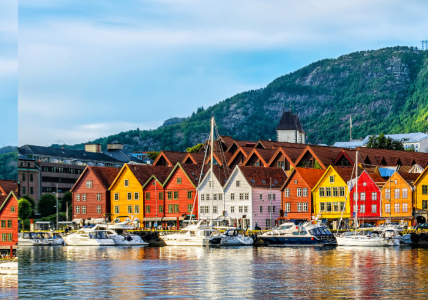How can ports become greener and smarter? DRYPORT (2008-2012) explored a concept that has proved very durable and still leads to positive spinoffs in the North Sea Region and beyond.
”Just call me any time, I have no holiday!” Dirk Harmsen has just started his new life as a pensioner; however, as I soon discover, he is still very much on the road and it is not all that easy to catch him at a quiet moment.
When we speak, I ask him about the legacy of the DRYPORT project, which he led. And then I discover something else: When you ask a ”Dryporter” about this 10 year old project, they are virtually unstoppable. Maybe because the project never really stopped, but has kept evolving ever since.
Reducing congestion at ports
Congestion was one of the main issues the project sought to tackle. ”Sea ports are really located on the wrong side of cities,” explains Dirk Harmsen. ”All transport to and from a port has to go through cities, which impacts the residents’ health and wellbeing. A single vessel can carry 18,000 twenty-foot containers!”
Moving the cargo on to trains for shipping inland would help alleviate congestion as well as noise and pollution from trucks in the city – and could even reduce CO2 emissions. ”These were the main reasons why we explored the concept of dryports – smart inland terminals connected to ports via rail or waterways.”
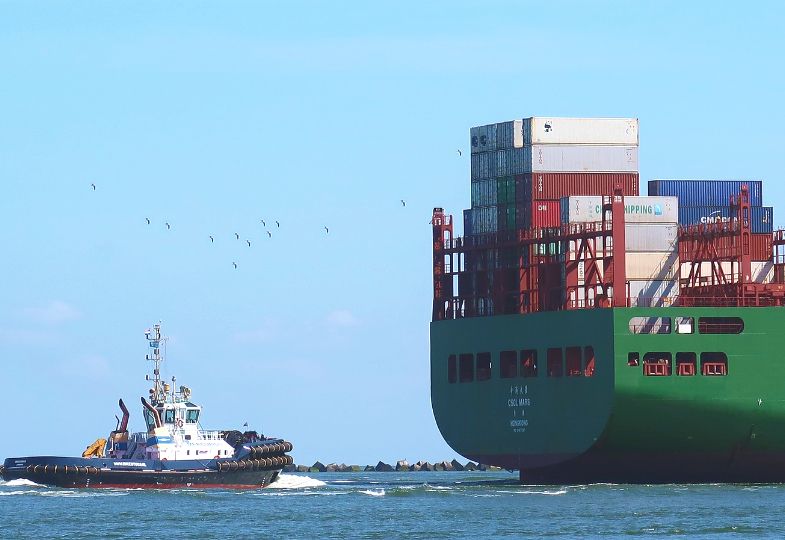
Container ship arriving to the Port of Rotterdam. In 2019, the port handled 13.5 million TEU (twenty-foot equivalents). It takes roughly 6 million trucks to transport this load. Picture: Ellen26/Pixabay.
The EU mobility strategy is designed to make transport green, smart and affordable. Among other aims, it calls for zero-emission ports; however, the task of transforming ports is daunting due to the sheer volume of cargo passing through.
In the third quarter of 2020 alone, the main EU ports handled 777 million tonnes of goods. That’s about the weight of 135 great pyramids of Ghiza.
What can Interreg do about issues that exist at such a massive scale? Quite a lot, as it turns out. DRYPORT kick-started a series of investments and left behind a legacy that is still growing.
Promoting the concept
In Falköping, Sweden, the project facilitated the cooperation of policymakers, public agencies, universities, and businesses, who worked together to create the Skaraborg Logistics Centre.
”The smart and intermodal hub concept was a clear success. It has been growing ever since,” states Ulf Eriksson, who was the Mayor of Falköping at the time.
Based on initial inquiries among the local industry, the municipality took a bold decision to buy land for the new cargo hub. They also promoted the concept to gain traction for the idea.
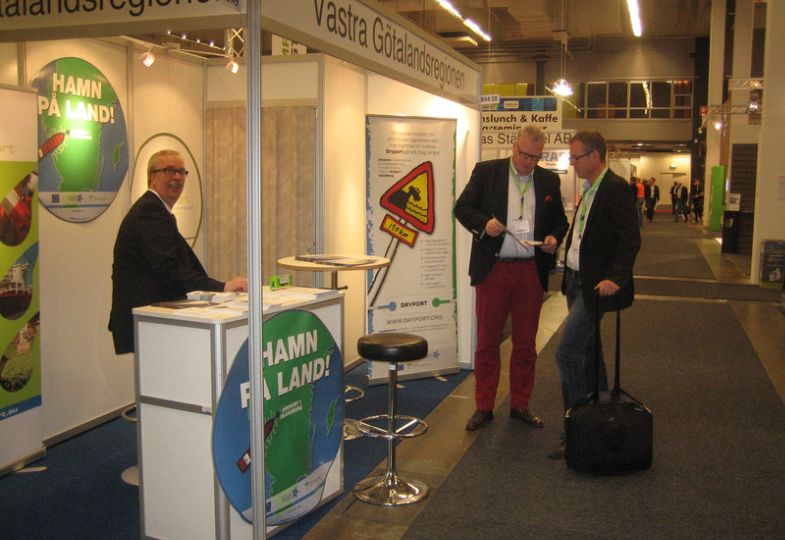
Leif Bigsten (left) promoting the concept in Sweden.
The project suffered a major setback in 2009 due to the economic downturn. However, the partners held out and endured, and the project saw its first major result in November 2010, when the Skaraborg multi-terminal was connected to rail.
The next breakthrough happened in the following year. ”Due to the interest of the company Stora Enso, we were able to launch a new timber terminal,” recalls Leif Bigsten, then Head of Development at Falköping Municipality.
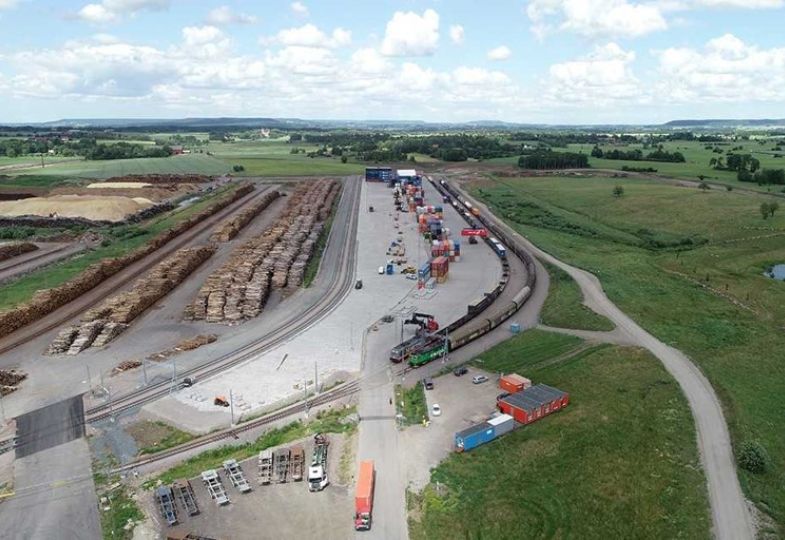
Timber terminal at the Skaraborg Logistics Centre (left) and container platform; first phase 2012.
A boost for the hinterland
Soon, other companies got involved, and the dryport is now a thriving cargo hub owned by Jula Logistics. Since DRYPORT, public and private sources have invested approximately €50 million in the hub, Bigsten notes. A significant part of the most recent investments comes from national climate funds.
Bigsten adds: ”Today, five terminals offer rail connection and about 1.5 million tonnes of cargo pass through the hub in a year. The hub is used for shipping goods between Sweden and Germany, and six to eight trains go back and forth to the Port of Gothenburg every day.”
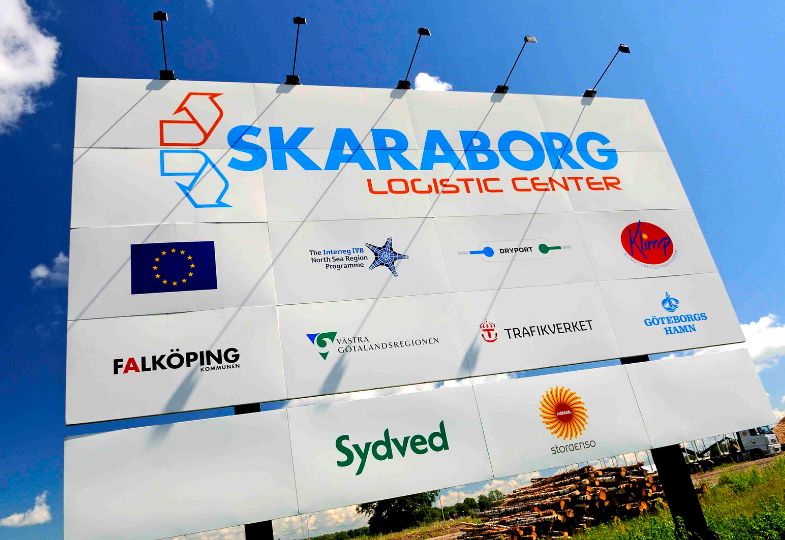
Signpost announcing the timber terminal at the Skaraborg Logistics Centre. Photo: Göran Assner.
The dryport is an important part of the regional economy, states Eriksson. ”Without it, we would simply not be where we are today.”
He estimates the Skaraborg complex employs around 200 people, in addition to supporting local jobs in construction and downstream industries such as tyre and fuel suppliers. The dryport infrastructure is also an asset for new industries looking to set up shop in the area.
Without the dryport, we would simply not be where we are today.
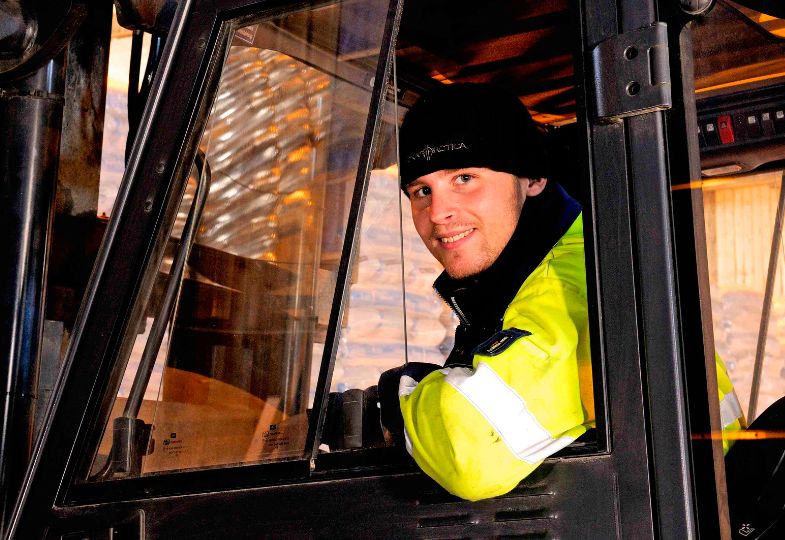
The dryport in Skaraborg has brought jobs to the area. Photo: Göran Assner
Multimodal choices a must for ports
Rail and waterways are climate-friendly options compared to road transport. At present, the rail options at Skaraborg hub save an estimated 12,000 tonnes of CO2 per year. This will grow to 28,000 tonnes once the expansion is realised.
Although the hub is located 120 km from the Swedish coast, it functions as an integrated part of Port of Gothenburg. In fact, DRYPORT helped the port develop its railport system, says Leif Bigsten. ”Meanwhile, they have reached 23 railway shuttles, and more than 50% of the containers are using rail.”
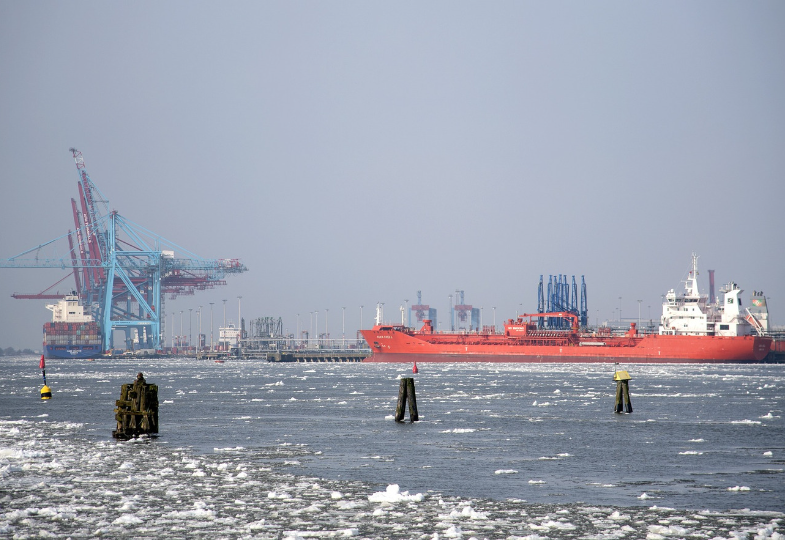
The Port of Gothenburg is the largest port in the Nordic region. Links to railway and smart cargo hubs in the hinterland are part of its recipe for greening its operations.
DRYPORT also supported a new dryport in the Netherlands. It is now an integrated part of the Euroterminal in Coevorden, offering railway links with the Port of Rotterdam and European destinations. In the past several years, it has been named a logistics hotspot in the Netherlands.
”The dryport is of vital importance to us for our current and future business climate. We’re confident it will support the growth of our regional economy and ecosystem in a sustainable way,” says Henk Brink, Regional Minister at the Province of Drenthe. The Province still uses the DRYPORT project logo for promoting its dryport.

DRYPORT successfully pushed for the shuttle between Coevorden and Malmö, which saves an estimated 4,500 tonnes of CO2 year on year. In 2021, the rail shuttle between Port of Rotterdam and Coevorden will double from three to six roundtrips per week. Together with the province and other stakeholders, the Euroterminal is looking to expand the dryport further and is promoting the dryport as part of the Dutch national Go Off-Road programme.
Large players looking for a strategic location are demanding multimodal access.
Paving the way for better ports
In the Flemish Port of Zeebrugge, DRYPORT kick-started massive investments in IT and intermodal transport offerings, says the port’s UK Trade Development Director Patrick Van Cauwenberghe.
”In a port, space is very precious – you have to do a lot of study to change one square metre. DRYPORT conducted studies that paved the way for large-scale developments such as two new rail tracks and a bridge spanning the inner and outer ports. The bridge alone saves 10 kilometres of road travel for every vehicle,” he says.
”DRYPORT also prompted us to install new IT systems and a border control station, which was very lucky when Brexit kicked in. Now, 50% of all incoming goods need to pass the control and yet we don’t experience long queues as in Dover and Calais.”
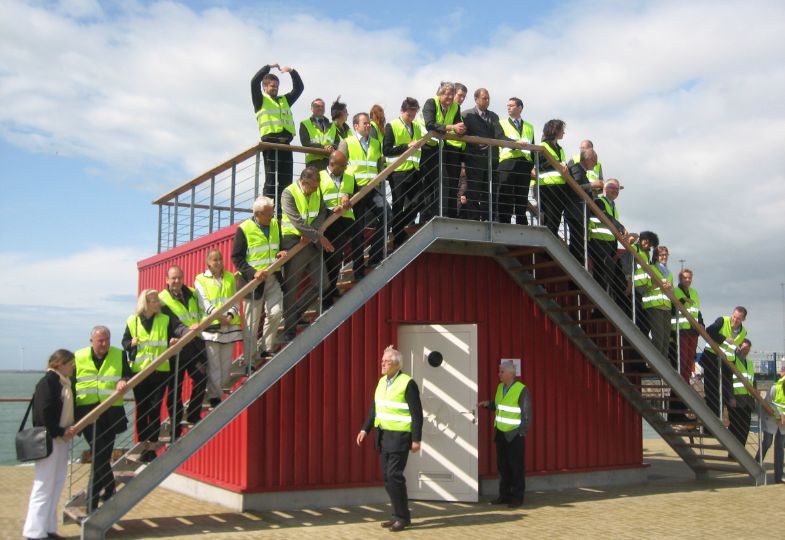
The Dryporters visiting the Port of Zeebrugge.
In the UK, DRYPORT supported infrastructure upgrades of both rail and road connected to the Port of Felixstowe, leading to removal of bottlenecks and increased use of rail for transporting goods. The project also led to a series of investments in warehousing and logistics. The UK partner Haven Gateway even developed a ”containerised cargo carbon calculator” to guide planners on climate-friendly transport options. Another EU-funded project, Low Carbon Freight Dividend, subsequently used the tool to help SMEs save more than 5,500 tonnes of CO2.
Also, DRYPORT put the rail route between Nuneaton and Felixstowe Port in the spotlight. Upgrades in the past decade have greatly increased the volume going to and from the port by rail.
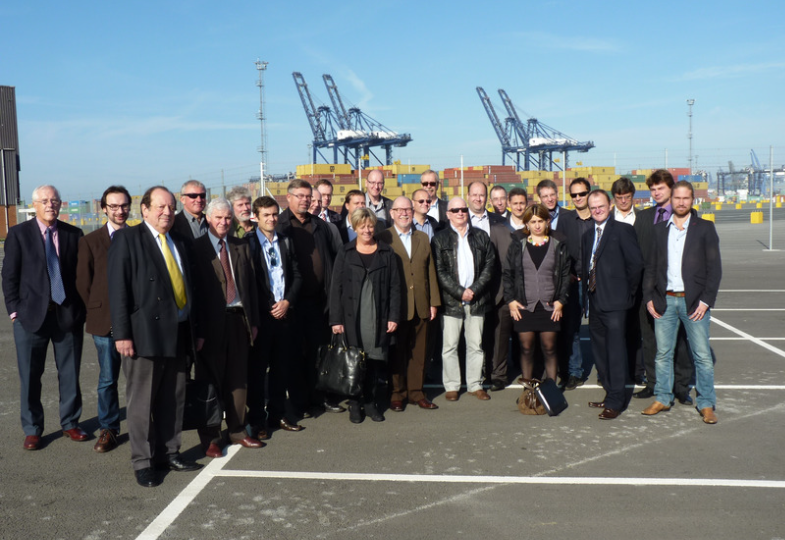
DRYPORT partners at the Port of Felixstowe.
A global voice for Port Community Systems
Yet another, and rather unexpected, result of DRYPORT was the founding of the International Port Community Systems Association (IPCSA). Port Community Systems manage the flow of information between a lot of agents, such as tax and port authorities, border control, forwarders, and railway companies.
Secretary General Richard Morton took part in DRYPORT, and he has been the linchpin of IPCSA ever since. “In DRYPORT, we brought in two companies – the UK-based MCP and Portbase from Rotterdam – to explain about these systems,” he says. This led to further dialogue and in June 2011, IPCSA (then EPCSA) was founded as a European association with support from DRYPORT.
Today, organisations such as the United Nations and the World Economic Forum recognise and consult with IPCSA. It boasts over 500 member ports, including the main European ports, the Indian Ports Association, and the Chinese Logistics Platform, among others.
IPCSA’s expertise is in high demand because it drives huge efficiency gains. “Take Ukraine, which used to have up to 40 days before the containers could leave the port because of all the paperwork. It takes about 30 minutes on average now,” says Richard Morton. And this certainly translates into cost savings: ”Rotterdam Port alone saves around 300-400 million euros a year.”
Morton says Port Community Systems are really about trust and bringing people together. This was exactly what happened in DRYPORT. “All our founding members are grateful because DRYPORT gave them a kick-start,” he concludes.
Before DRYPORT, nobody talked about dryports, but now there is a clear recognition of their importance. The project helped raise the profile of dryports in Europe and globally.
Teaming up with science
Dirk Harmsen highlights the role of universities: ”The project’s science leg and independent analyses were important because you need solid ground for big decisions. It made it easier for the involved authorities to agree and avoid any skirmishes.”
Rickard Bergqvist, Professor of Logistics and Transport Economics at the University of Gothenburg, provided research for DRYPORT. He recently co-authored another article about the Skaraborg hub – an example of a productive, long-term cooperation between the University of Gothenburg and Napier University in Edinburgh that began with DRYPORT.
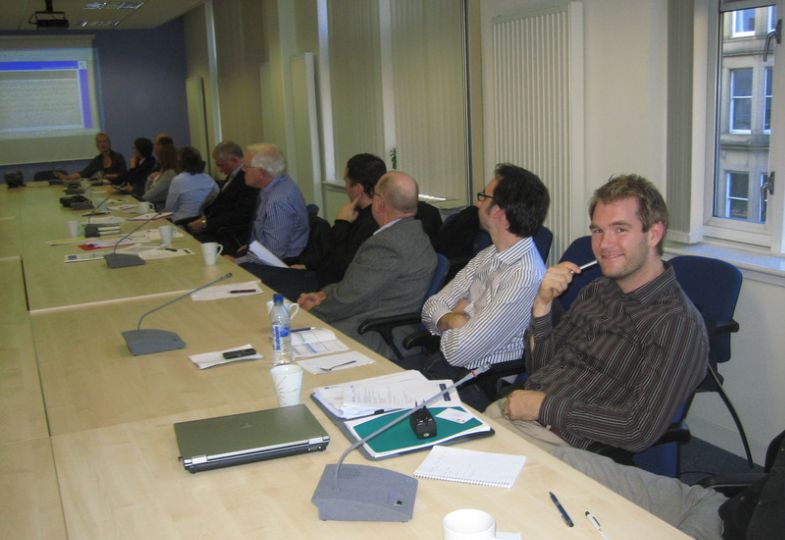
Professor Rickard Bergqvist attending a DRYPORT meeting
”The Skaraborg hub is one of the most successful examples of dryports anywhere in the world,” Bergqvist says. He finds the public-private ownership dynamics are a key reason why it has done so well.
”To make a dryport work in a place like Falköping, many companies need to collaborate and share the benefits. Initially, the municipality kick-started the process through public investment and by facilitating cooperation; later on, they wisely took a step back and gave space for the private sector to take over.”
The DRYPORT project definitely influenced my academic career.
Trust goes a long way in greening ports
Though far removed from the sea, dryports clearly have a role to play in the transition that European ports are heading toward. DRYPORT provided many proof points that have only grown stronger over time.
Meanwhile, it has inspired developments far beyond the North Sea Region and even reached Riyadh in Saudi Arabia, where the DRYPORT team were invited to present their concept at a conference. ”It was interesting to discover that our pilot of 70 hectares could inspire this huge project of 40 square kilometres that they were planning for,” says Dirk Harmsen.

A typical train of around 630 metres can carry 80 twenty-foot containers. Roughly 35-40 trucks would be required for transporting the same amount of cargo. Photo: Göran Assner
During the past decade, DRYPORT has resulted in reduced congestion in port cities, massive carbon savings, and jobs in the hinterland, just as the partners had hoped it would. Other results – such as the evolution of IPCSA – were completely unforeseen, but welcome, outcomes from the project.
How did DRYPORT manage to set all these developments in motion? According to the people who were involved, trust and relations created through the Interreg cooperation played no small part in it. That is also why they still care about the project, although it closed nearly 10 years ago.
In conclusion, never underrate the human element if you want to build solutions for the long haul!
Dryports are smart hubs that require sharing of commercial information across many parties. That is why mutual trust and respect are at the heart of their success.
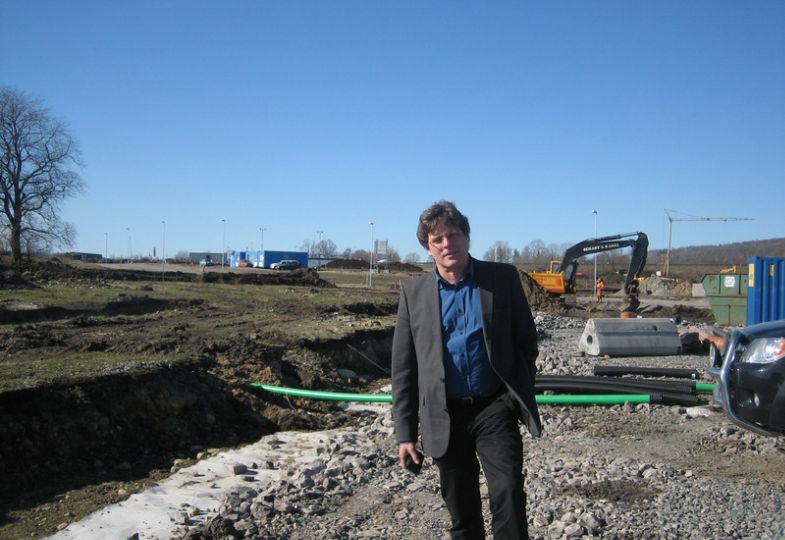
Snapshot from 2009: Project manager Dirk Harmsen inspects the site that would later become the thriving Skaraborg hub.
Saving carbon emissions
DRYPORT moved freight from road to rail and waterways, saving many thousand tonnes of CO2. The impact keeps growing year on year as the concept expands.
Raising the digital bar
DRYPORT promoted smart IT-driven cargo hubs that save cost and time. This focus led to the formation of a leading global organisation, IPCSA.
Boosting local development
In Sweden alone, DRYPORT has driven investments of over €50 million and created more than 200 jobs in the hinterland of the Port of Gothenburg. These numbers are set to grow further.
Learn more about DRYPORT
You are welcome to contact the former project manager to learn more about this project and its concepts:
Dirk Harmsen, mobile + 46 705144977, email info@terranordica.com.
Explore the DRYPORT legacy
Visit the websites below to learn more about the examples mentioned above and where they are today.
Skaraborg Logistics Center (dryport in Sweden)
Euroterminal Emmen/Coevorden (dryport in the Netherlands)
Port of Zeebrugge (Flanders)
Port of Felixstowe (UK)
International Port Community Systems Association (IPCSA)
Website of DRYPORT (archived)
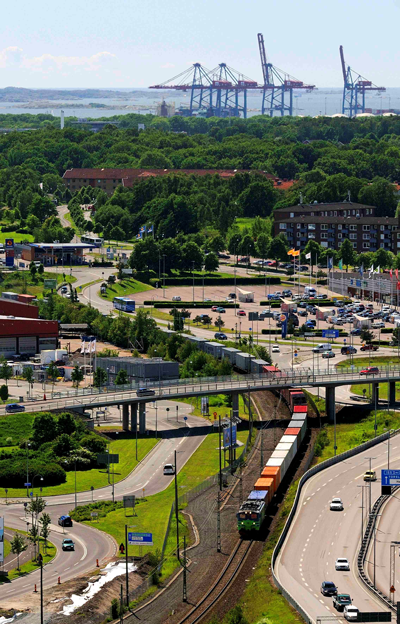
Cargo train travelling inland from the Port of Gothenburg. Photo: Göran Assner.


